OBAYASHI TECHNICAL RESEARCH INSTITUTE MAIN BUILDING
Ecological roof system
 |
|||
| Schematic view of ecological roof system | |||
 |
|||
A slanted roof and a north-facing high side light were installed on a wide upper portion of the room. A system that diffracts skylight with less fluctuation on a reflecting surface on the ceiling and lets it into the workspace eliminates the need of lighting during daytime. Solar panels installed on the entire of the slanted roof generate power highly efficiently and provide enough energy for lighting used in the workspace during nighttime. The shape and color of the ceiling and walls in the room was decided with consideration for ensuring "brightness."
Peri-buffer system
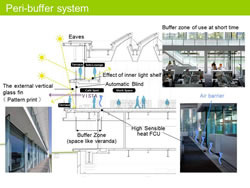 |
|||
| Schematic view of peri-buffer system | |||
 |
|||
A thermal buffer zone established around windows reduces air-conditioning loads.
In addition to the use of exterior that controls solar radiation, a buffer zone is established in a perimeter zone (peri-buffer zone) on the indoor side to reduce energy requirement for air conditioning. This peri-buffer zone is intended to control impact of air-conditioning loads on the inside working zone, and consists of aisles, meeting space and lounges that are located around the working area and adjacent to an outdoor deck. In this zone, air-conditioning temperature can be adjusted because people stay there relatively for a short time. Locating these magnet spaces around the central working zone allows for a decentralized flow of people to the surroundings. It is expected that face-to-face communication will be enhanced by meeting other people and finding something when they move around.
Displacement natural ventilation system
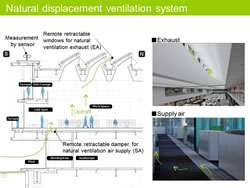 |
|||
| Schematic view of natural displacement ventilation system | |||
 |
|||
A natural ventilation system for the entire workspace through the floor and the ceiling. When outside air meets the predetermined conditions, an air-conditioner is stopped automatically. Then, outside air flows into the workspace through openable outlets under floor. The air is discharged from high side lights on the upper of the building, and displaced with fresh. In addition, based on the direction of prevailing wind, green space is maintained in the southern area outside the building while the existing forest is preserved in the northern area. This helps control adverse effects of increase in outside air temperature caused by sunlight reflected by exterior pavement materials.
Sensible/latent heat separated personal radiant air-conditioning system (O-TASC)
 |
|||
| Schematic view of Sensible/latent heat separated personal radiant air-conditioning system | |||
 |
|||
A new task/ambient air-conditioning system that allows for personal air-conditioning by using radiative-convective task panels.
While semi-task zones are formed in an ambient zone by using personal blower outlets on the floor, radiation and convection generated by task panels installed on partitions form comfortable task zones that are controlled to maintain sensible temperature for staffs. In this system, latent heat and sensible heat are treated separately. In semi-task zones, a desiccant air-conditioner treats latent heat of the outside air properly, and brings it into the zones through blower outlets on the floor. Heat from the cogeneration system is used for reusing rotors of the desiccant air-conditioner. On the other hand, task panels treat sensible heat generated from human.
Lighting/Air-conditioning control system using IC tags
 |
|||
| Schematic view of lighting/air-conditioning control system using IC tags | |||
 |
|||
IC tags that are used for security control detects if individual staffs are at their seats and in the office, and task lighting and air-conditioning systems are controlled to be turned on/off. Detailed switch control depending on the required time and location allows for eliminating unnecessary energy use. It will be possible in the future to control those systems according to the preferences of individual staffs by using IC tags.
Hybrid heat pump system of geothermal and well-water heat
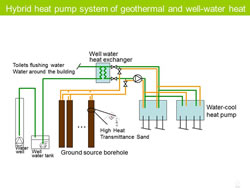 |
|||
| Schematic view of geothermal and well water using system | |||
 |
|||
A heat source system that utilizes stable geothermal power throughout the year. Geothermal power is utilized highly efficiently by using a heat collecting tube filled with high thermal conductive sand. In addition, well water is used as heat source for the heat pump to improve the efficiency in heat source operation. The well water that is used for a heat exchanger is reused for flushing toilets and watering around the building (cascading).
Medium chilled water latent heat storage system
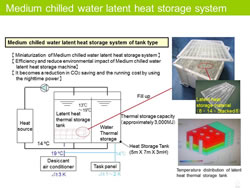 |
|||
| Schematic view of medium chilled water latent heat storage system | |||
 |
|||
A heat storage system using latent heat storage material that freezes and melts alternately at medium temperature. Using cold water of medium temperature improves operation efficiently of heat source. Furthermore, storing heat levels electric loads, reduces operation costs, and allows for significant reduction in the capacity of a heat storage tank.
Visualization system
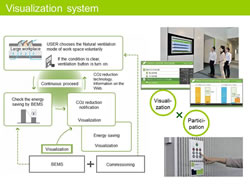 |
|||
| Schematic view of visualization system | |||
 |
|||
The visualization system displays the effects of environmental measures on the monitor for occupants by utilizing the energy data obtained from BEMS. It calculates and displays energy usage and its reduction in terms of CO2 emissions by items on a real time basis. Those data are always displayed on signages in the workspace together with general information for occupants.
Previous Building |
 |
 |
 |
 |
 |
 Next Building Next Building |
CASBEE is a method for rating the environmental performance of buildings using Building Environmental Efficiency (BEE) as an indicator, which is based on the results of separate scores obtained for Q-1~Q-3 (Quality) and LR-1~LR-3 (Load Reduction).















 | Copyright © 2008 Institute for Building Environment and Energy Conservation, All Rights Reserved.
| Copyright © 2008 Institute for Building Environment and Energy Conservation, All Rights Reserved.